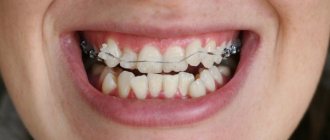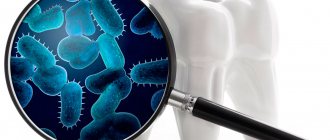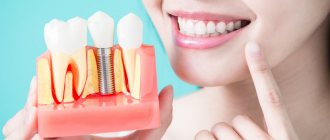Teeth whitening in dentistry
It seems to modern people that snow-white teeth have always been an integral attribute of an attractive appearance, but this is far from the case. During the Roman Empire, wearing gold dentures was considered a blessing—a symbol of power and prosperity (by the way, in Russia, gold crowns once played the same role). The aristocracy of the Middle Ages was proud of rotten teeth - a sign of high origin and wealth. In Ancient China, things were no better: women deliberately made their smile black in order to please the future groom. Of course, darkened teeth were not held in high esteem everywhere and not at all times, and there were people who were looking for more and more new means for whitening them.
Laser teeth whitening - description of the process
A dilator is inserted into the mouth, which bends the lips and fixes the jaws in an open position. An active gel is applied to the teeth. Usually, only the “smile zone” is treated - the front 8 teeth, but if desired, the procedure can be done with the entire remaining jaw. This will significantly increase the cost of the service, since it is calculated based on the number of teeth whitened.
The second stage is laser treatment of the oral cavity. Each tooth takes 1-2 minutes, and one session takes up to half an hour. Depending on the desired result, from 1 to 3 treatments may be required. They can be carried out either one day or with a break of 1-2 weeks.
Teeth whitening methods
All types of teeth whitening can be divided into professional and non-professional. The first ones are carried out by a doctor in a clinic or by the patient himself at home under the supervision of a doctor. These include methods such as photobleaching, laser, chemical bleaching, endobleaching and home whitening using caps. Each of the listed methods of teeth whitening has its own pros and cons, indications and contraindications.
The second group includes various whitening products that can be purchased freely and used independently without the participation of a specialist. We are talking, first of all, about whitening pastes. Non-professional whitening includes special whitening plates, pencils and systems with universal trays, but doctors still do not recommend using them yourself, since careless use of such products can lead to complications such as sharp pain during whitening and increased tooth sensitivity after it.
How long does teeth whitening take?
In the case of professional whitening, many specialists prefer the laser procedure.
This procedure is more gentle and does not cause virtually any side effects, unlike chemical bleaching. The laser procedure should last about 15 minutes, the result will be noticeable after the first procedure.
As for chemical whitening, the procedure can take up to an hour and a half. In addition, in this case, side effects in the form of burns are possible.
If we talk about cleaning teeth at home, then they are even more dangerous for the health and condition of the teeth.
- First of all, you cannot decide for yourself whether teeth whitening is harmful in your particular case. Only a specialist can answer this question. For this reason, you need to be extremely careful when self-medicating.
- If you use chemical elements in whitening at home, you can simply mix up the dosage and completely dissolve the enamel, or get even more serious damage.
- Many popular councils may be ineffective or simply not work at all.
As for contraindications, they are the same for both professional whitening and home whitening, these are:
- Various pathological changes in the gums and teeth.
- Women during breastfeeding.
- Periodontal disease.
- Excessive tooth sensitivity.
- Presence of seals.
Effective teeth whitening
Before the patient agrees to whitening, the doctor must warn that the results may be disappointing. This is especially true for complex cases, such as teeth with fluorosis. In addition, the patient should be warned about the possible replacement of old restorations. Whitening of fillings, crowns, veneers or implants is not possible.
The most effective methods of teeth whitening are professional techniques. The leading place in terms of effectiveness is occupied by laser whitening, which to some extent can even cope with tetracycline teeth. Then comes photobleaching - the most famous and popular in-office technique today. Closing the top three is the chemical technique, which is used very rarely, but definitely deserves attention. Home professional whitening is also quite effective, but to get results you need to take a fairly long course.
As for non-professional whitening systems, the most effective of them are those that contain hydrogen peroxide or carbamide peroxide. All other products without the listed active whitening substances have only a good cleaning effect from plaque and polishing the tooth surface.
If we talk about the effectiveness of whitening in general, then, even when using the same product, different patients will have different results. The best and fastest effect is achieved by whitening teeth with natural yellowish tints; teeth with grayish shades are less bleached. And although everything depends on the specific case, to say that the effect of the procedure is completely unpredictable is also wrong. A dentist who has good practice can predict the outcome in simple clinical cases.
What you need to know before the procedure
Teeth whitening is a fairly effective procedure, and many patients manage to achieve the desired effect: the teeth become noticeably lighter by several shades, which cannot be ignored after the whitening is completed. However, not all patients know that the effect of such a procedure is temporary and it is impossible to know exactly how long teeth whitening lasts. Unfortunately, even with the current level of science, it is not possible to achieve lifelong whitening of teeth. After some time, the patient will have to contact the doctors again and repeat the procedure.
When teeth whitening, how long the effect lasts depends on which parts of the tooth are being whitened. During the procedure, chemical reagents only affect living tooth tissue, and whitening will only take place in this area. That is, the installed fillings simply will not stain and will not change their gray color. Therefore, before bleaching, doctors place the lightest types of dental fillings , which will differ minimally from the bleached surface.
Composition of whitening gels
For various methods of professional and non-professional teeth whitening, special whitening gels are used, the active substances of which are hydrogen peroxide or carbamide. Sometimes the preparations include amorphous calcium phosphate, fluoride or potassium nitrate to treat minor damage to the enamel, as well as to make teeth brighter and glossier after the procedure. In some cases, the whitening gel may contain special components that have a soothing effect on the teeth and gums.
What types of whitening are there?
31.10.2020 18:49
Teeth whitening is divided into in-office and at-home. In-office teeth whitening is carried out in the dentist's chair, while at-home teeth whitening involves independently wearing trays specially made by the dentist for 2-3 weeks, which are filled with a professional whitening composition. Typically, home whitening is prescribed in addition to office whitening.
How long does teeth whitening take?
Office whitening, including machine whitening, has become a very common dental procedure today. It is performed in a dental chair under the supervision and control of a dentist and usually lasts about 1.5–2 hours. The main method of in-office teeth whitening is the use of a high concentration of whitening gel and a catalyst that can speed up the whitening process. Such accelerators of chemical reactions can be ultraviolet radiation from a special lamp, laser radiation, heat and special chemical compounds. Let's briefly talk about some of them.
Ultrasonic whitening is the most gentle
One of the most gentle teeth whitening methods is ultrasonic whitening. With this method, dental plaque is removed with specially designed instruments - ultrasonic scalers. The special sharpening created for them prevents damage to tooth enamel. The dentist applies the gel to the teeth, and then, under the influence of ultrasound, the gel releases active oxygen and thereby gently lightens the enamel.
Photo whitening of teeth – protection against caries
The method of photo-whitening teeth is also gentle. Before starting the procedure, the dentist isolates the soft tissues of the oral cavity. The surface of the teeth is coated with gel, and then illuminated with the light of a ZOOM halogen lamp, under the influence of which active oxygen is released from the gel. It penetrates through the enamel into the dentin and breaks down the tooth pigment into colorless components. Today, together with ZOOM whitening systems, they began to use amorphous calcium phosphate, which fills defects and scratches on tooth enamel and immediately crystallizes, forming insoluble apatite (a structural component of tooth enamel). During the photobleaching procedure, the permeability of the enamel is reduced, the sensitivity of the teeth is significantly reduced, and protection against caries is provided.
Laser whitening – increased efficiency
Laser teeth whitening is not as gentle, but more effective. During the whitening procedure, a hydrogen peroxide-based composition is applied to the teeth, which is then activated using a laser beam. Whitening teeth enamel lasts a matter of seconds. The laser teeth whitening method will not harm your teeth, and the aesthetic result is simply excellent! Depending on the selected mode of action, the laser can lighten the enamel by several tones at once. In addition, the laser radiation itself has bactericidal properties, which also protects teeth from caries.
Summing up
Whatever teeth whitening method you choose, your tooth enamel will be smooth, even, and exactly the color you like!
Teeth whitening procedure
In the whitening procedure, it is very important to strictly follow its protocol.
- Before you start whitening your teeth, you need to conduct a diagnosis: find out the reason for the change in the color of the tooth enamel, take an x-ray, examine the gums and check the condition of the teeth. Based on the data obtained, the doctor selects the whitening system that is most suitable in this case.
- This is followed by mandatory professional teeth cleaning.
- Before and after the whitening procedure, remineralization therapy is performed.
- Rapid in-office teeth whitening is performed in the clinic directly by a dental hygienist. A gel with a whitening agent concentration of at least 30% is applied to the teeth, which is activated by light, laser, or acts on its own. The duration of the procedure depends on the specific technique, but, as a rule, only one visit is required. For home whitening in dentistry, individual trays are made, and a suitable whitening gel is selected. The patient carries out the procedure itself at home, following the doctor’s recommendations. The gel is applied to trays, which are placed on the teeth and worn once or twice a day or left overnight, depending on the teeth whitening technology. The course can last from two weeks to a month.
- At the end of the procedure, the result obtained is assessed using the VITA scale.
Important!
After teeth whitening, you should not smoke, drink red wine or coffee, or consume any foods with strong coloring pigments, such as red berries and beets.
The effect of white teeth can last from six months to several years. It is very difficult to say exactly how long teeth whitening will last, since it depends on many factors. To maintain long-term results, it is recommended to use maintenance whitening products for home use - pastes or rinses, as well as adhere to a transparent diet. In addition, good oral care and regular professional cleanings can also help maintain a snow-white smile for a long time. It is likely that sooner or later the procedure will have to be repeated, but according to many experts, the original color of the teeth will not return.
Can children have their teeth whitened?
Today, teeth whitening is one of the most popular services provided in dental clinics. However, the issue of carrying out this procedure in children is extremely delicate. Let’s take a closer look at in what cases and how to whiten a child’s teeth, whether the procedure can be carried out at home, and what is included in the cost of whitening in a dental clinic.
Why do teeth change color?
There are three main reasons why unsightly dark streaks may appear on your teeth. The first of them is associated with the use of tetracycline antibiotics by the mother during pregnancy. Change in tooth color in this case is a consequence of a violation of mineral metabolism. The second reason is fluorosis, which develops due to excess fluoride in drinking water. And the third is a disruption of the normal process of tooth growth, which sometimes becomes a consequence of treatment of baby teeth.
At what age can you start whitening your teeth?
Children are allowed to have their teeth whitened no earlier than 16 years of age. In addition, children under this age usually do not yet have plaque or tartar deposits, which may require a procedure.
What preparation is needed before bleaching?
Before the procedure, it is very important to undergo an examination by a dentist, who can identify diseases and contraindications for whitening. If necessary, the specialist prescribes treatment for diseases of the teeth and gums. Also, before the procedure, professional cleaning is carried out (to remove tartar), and teeth are fluoridated and polished.
How does whitening work?
According to the technology of the procedure, the teeth are first treated with a special gel containing hydrogen peroxide. It is activated by a lamp through irradiation. Due to the fact that light of a certain frequency is used, overheating of the dental nerve is prevented. During the procedure, active oxygen is released, which subsequently penetrates the enamel and dentin, discolors dark pigments and does not change the structure of the tooth. Finally, the specialist treats the teeth with preparations that contain fluoride. At the same time, active fluoride acts for several more days, due to which it further increases the whiteness of teeth.
Why you need to whiten your teeth in a professional clinic
It is extremely important that teeth whitening for a child is carried out by a qualified specialist who will conduct a preliminary examination, be able to assess the condition of the enamel, and determine the optimal whitening method and the number of procedures. It is important to remember that when whitening at home, there is a risk that the enamel will be damaged. Thus, small chips and cracks may appear, which will be invisible to the naked eye if the procedure is carried out independently. In addition, in most cases, a professional will be able to provide a quick visible result. This means that in one procedure he will be able to lighten teeth by 4-10 shades - this result is unattainable at home.
What is included in the price of the procedure
Many parents are concerned about how much teeth whitening costs and how many procedures will be needed to achieve optimal results. In fact, each case is individual, and before talking about the total cost of the procedure, the dentist must examine the child. In addition to the examination, the specialist will conduct professional cleaning and, if necessary, prescribe treatment. All this is included in the final price along with the whitening itself. The price may be influenced by the degree of impact on the enamel of the drugs used, the duration of the procedure, and even the initial condition of the tooth enamel.
Complications after teeth whitening
The most common problem that patients encounter after whitening is increased tooth sensitivity. The cause of painful sensations is the process as a result of which the teeth, under the influence of the whitening gel, lose moisture and are then re-saturated with liquid. Remineralizing therapy before the procedure and the use of special medications help neutralize pain after teeth whitening. Increased tooth sensitivity can also be relieved by taking painkillers.
Is teeth whitening harmful and can it harm the enamel?
It is worth saying that any gels, both in professional clinics and at home, penetrate directly into the enamel. In this regard, many are afraid to use the whitening procedure.
Of course, after a single bleaching, there should not be any significant changes in the condition of the enamel. However, you should not get carried away with this procedure. In case of frequent use of professional whitening, the following may occur:
- Irregularities in the enamel.
- Color change.
- When performing a whitening procedure, a person suffering from caries may experience very strong painful sensations, which can lead to pulpitis.
Is teeth whitening harmful? This is a question that does not have a clear answer. Only a doctor can give you an accurate answer to the question; without his consultation, you should not carry out any such independent whitening actions.











